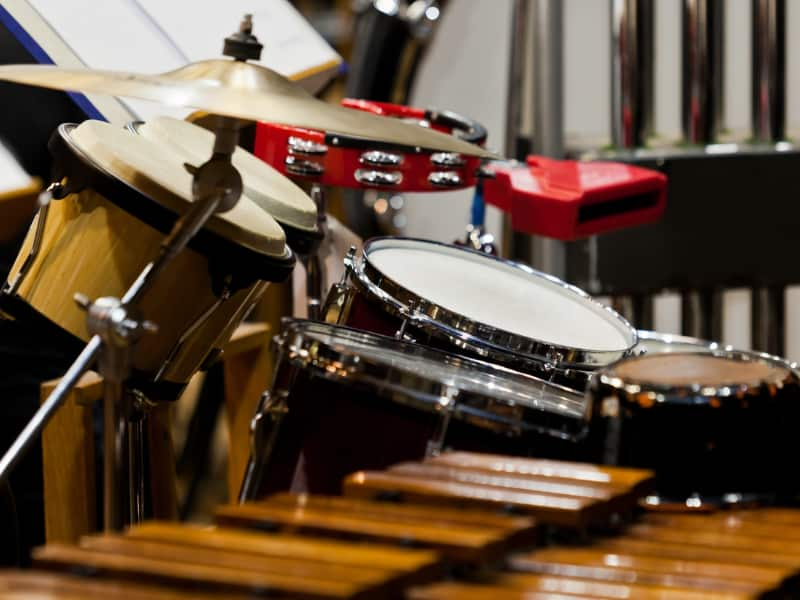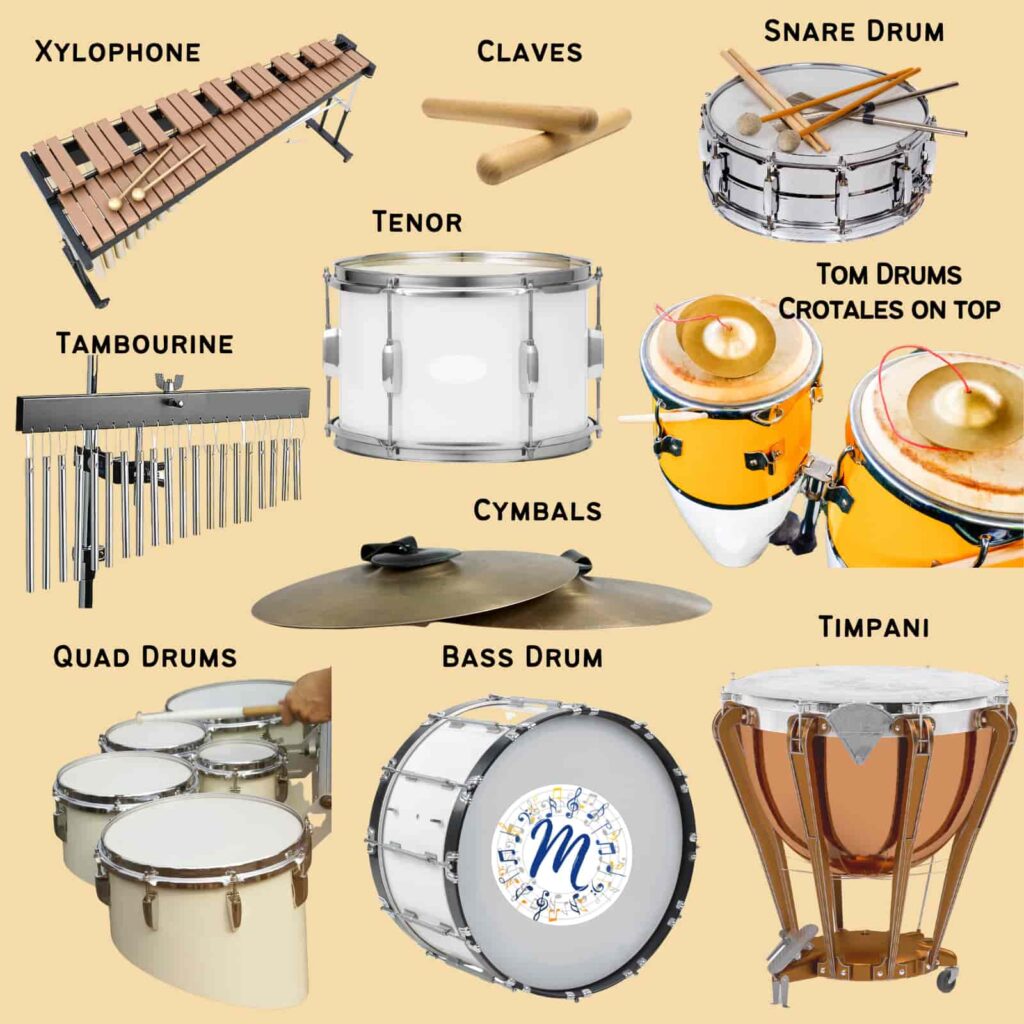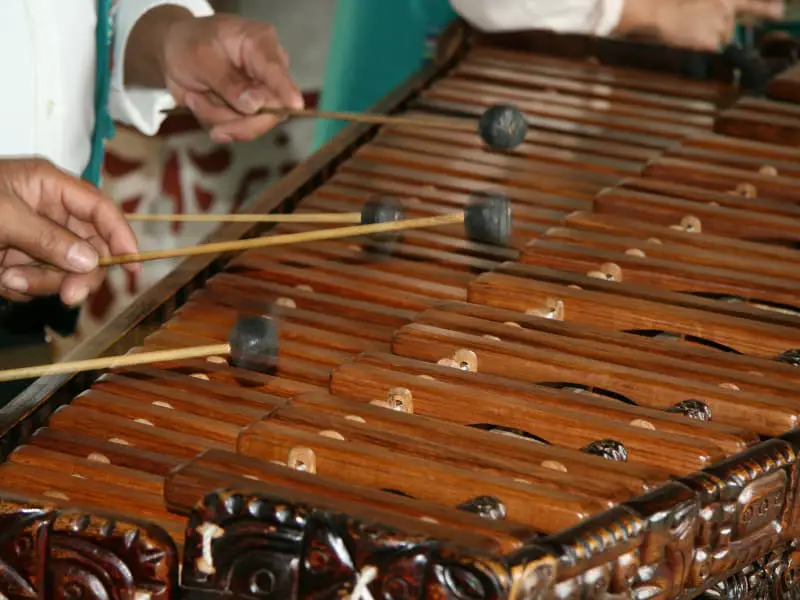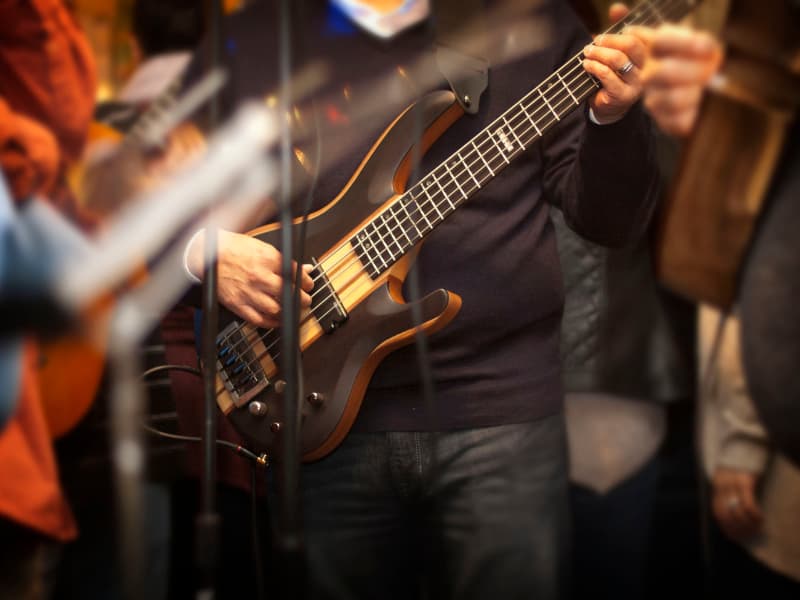Indoor percussion ensembles have evolved from something for marching band musicians to do in their off-season into stand-alone careers for aspiring musicians of all ages.
These ensembles, made up of battery percussionists, pit percussionists, and sometimes even flag corps members, create stunning visual programs while performing some of the most difficult musical pieces written for large percussion ensembles.

This phenomenon brings 14-22 year-olds into another world of competition, artistry, and teamwork, and provides an opportunity to meet musicians from a variety of backgrounds. It’s not free but the benefits of participation are many.
Read on to discover what is different about indoor percussion compared to marching band and how to get involved.
What is indoor percussion?
Indoor percussion is an ensemble of percussionists who compete or perform programs indoors in a stadium or gymnasium. This event usually takes place during the off-season of marching band. The indoor percussion ensemble includes both marching (battery) percussion instruments and Frontline (pit) percussion instruments.
Indoor percussion ensembles use theatrical elements, minimal scenery, creative props, eye-catching costumes, detailed choreography, and dramatic music to create a visually technical and challenging auditory spectacle.
Percussionists in high school and college have many opportunities to party in a large variety of indoor percussion ensembles because many high schools and colleges now offer this musical outlet. There are also privately sponsored groups worldwide that accept percussionists ages 14-22 into their indoor percussion ensembles and regularly compete for titles, trophies, and cash prizes.
Indoor Percussion Features:
- One of the unique features of indoor percussion ensembles is the music. The instrumentation is completely percussive. There are no brass or woodwind instruments, only percussion, so the melodies and harmonies in the music are provided exclusively by the mallet instruments.
- A second unique feature is the size of the performing space and how indoor percussion ensembles are encouraged to use that space. The indoor performance space is 60′ x 90′ which is significantly smaller than a full football field which marching bands normally perform on.
- The performers in an indoor percussion ensemble use their whole body to communicate the mood of the music and the synchronized elements of the musical choreography. Often flags or other props will be used to support the visual theme of the song or program.
What instruments are in indoor percussion?
Battery and pit instruments are in indoor percussion. The battery or drum line consists of snare drums, bass drums, tenor drums or toms, and cymbals. The pit or front ensemble consists of auxiliary percussion, large percussion instruments which are unable to be maneuvered quickly, and mallet instruments.

Battery Percussion
Marching snare drums are different in size and construction than concert snare drums. They’re made for higher tension on the head and better projection of sound. Marching snare drums also require a harness.
Marching Bass Drums are large drums that produce the lowest notes in the drumline. They are tonal drums; each size has a different pitch than the other and will be found in graduating pitch order.rum
Tenor drum sets can have a range of sizes including 6, 8, 10, 12, and 14. The smallest drums can be doubled in a set and used to create a “shot” drum which produces a loud “crack” used for heavy accents and loud effects.
Hand crash cymbals used in marching percussion are different from those used in concert bands or orchestras. Some marching bands will employ multiple sets of cymbals differing in size to create a variety of sounds.
Front Line Percussion (Pit)
Marimbas have a dark, warm sound that can blend into an ensemble. The marimba has a bigger range and lower notes than the xylophone with resonator tubes on each tone bar.
The xylophone produces a variety of higher-pitched sounds by striking suspended tone bars with mallets of different hardnesses. The tone bars vibrate and a resonator tube placed underneath some of the tone bars amplifies the vibration-produced sound.

The Vibraphone has metal tone bars like the Glockenspiel. The Vibraphone has a larger and lower range of sounds and tones than the Glockenspiel and is able to sustain and vibrate its tone longer.
- Bells
Bells in the pit are high-pitched mallet percussion instruments with metal bars. They can also be called glockenspiels. Mallet percussion instruments that are played in the pit can cover a wide range of notes.
Chimes (Tubular Bells) have a similar sound to carillon or church bells and are struck with a hard mallet that resembles a hammer.
- Electronic Keyboard
Some indoor percussion ensembles use a synthesizer or electronic keyboard to add a variety of sounds like piano, stringed instruments, or special effects.
- Bass Guitar
A bass guitar, although not part of the percussion family, is sometimes used to provide a rhythmic or stylistic “bottom end” to the indoor percussion ensemble’s performance.

Timpani have been used in music since Medieval times and have worked their way into Operas, orchestras, concert, and marching bands. Even some rock drummers have included timpani in their large drum sets.
The Concert Bass Drum is one of the largest drums in the percussion section, ranging from 28 to 40 inches across. It provides the booming downbeats and accents while being able to be quietly muffled or forcefully struck. The concert bass drum sounds hard or round depending on the size and structure of the mallet used to strike it.
Auxiliary percussion includes instruments like Shakers, the Slap Stick, Jingle Bells, the Triangle, and Tambourines. Each auxiliary percussion instrument has a specific technique and correct way to play it in order to get the best sound from it. The complete list of Auxiliary percussion is a curious combination of sticks, whistles, things that vibrate, and even an anvil.
Note: Because the mallet instruments are the main melodic instrument of the ensemble, there may be multiple marimbas, xylophones, vibes, bells, chimes, or even an electric keyboard. Some ensembles add an electronic keyboard and a bass guitar to fill out the sound.
How do I start an indoor percussion group?
You can start an indoor percussion group with a vision, a group of percussionists, the right equipment, and time set aside to perfect your program.
Five Steps to Start an Indoor Percussion Group
- First decide what your group will look like and sound like based on the staff and students you have. 🎵 How many staff do you have to help?
🎵 What are their strengths?
🎵 What level are your percussionists performing at?
🎵What level of music and movement can they pull off?
Start there and build. Set goals for the future and grow your group. - Next, create a program that shows off your strengths as a group and makes your group different from others.
🎵 Take some time to see what others are doing.
🎵 Choose music that is challenging and that highlights your group’s uniqueness.
🎵 Do you have an amazing snare line? Feature them.
🎵 Are your mallet players exceptional? Then make sure that they are wowing our ears with their technique. - Ensure that your equipment is the best you can afford. Your batter percussion will be moving and trying to look sharp visually so ensure that your harnesses and mounting equipment is up to that level of extra duty.
Make sure that your frontline or pit instruments are sturdy enough to handle the quick movements required to get on and off of the performance space in a timely way.
You may need to build some moveable platforms or stronger wheelbases for all pit instruments or ensemble groups. - Now that you have the staff, standards, and equipment is taken care of, it’s time to put in the work. Your practice times should be focussed on the basics of moving as a unit, getting comfortable in the smaller performance space, unity in your movements, and how to accomplish theatrics and dynamics in your visuals.
And the real discipline will be to accomplish all of that while raising the bar on your sound and the group’s overall musical performance.
The movements should be flawless but so should the musical presentation. - Finally, practice, evaluate, and adjust. It takes a lot of time to develop and perfect a flawless indoor percussion show that is both entertaining and technically stunning.
Keep it fun but stay motivated and strive for excellence. Pay attention to other groups that have been doing indoor percussion longer. Learn from them and network as much as possible. Performing a flawless routine is a pleasure to your audience and a sense of accomplishment for your ensemble.
How much does indoor percussion cost?
Amateur indoor percussion groups sponsored by high schools, colleges, or local agencies have varying costs based on what they will be doing. Some high schools ask for between $300- $1,000 to cover the student cost of uniforms, accommodations, and travel expenses.
Professional indoor percussion costs vary, $1,600 plus additional fees which depending on the group, accommodations, travel, meals, and camps for rehearsal.
Indoor percussion is an extracurricular activity so the fees associated with it may not be fully funded by your school. Consult band directors for the specifics. Professional or civic groups usually have a web page or contact information available so that you can get all the answers, deadlines, audition dates, and fee schedules.
How to find an indoor percussion ensemble to join?
What colleges have indoor percussion ensembles?
Finding an indoor percussion ensemble to join is as easy as a Google search. Most groups have a website and are listed on other major websites like marching.com, or the Winter Guard International (WGI) home page. Colleges that have indoor percussion ensembles will usually note that on their music department website.
Indoor Percussion Ensembles: MARCHING.COM Links Directory
The Marching.com links directory lists websites related to high school marching bands, college bands, drum and bugle corps, color guards, and drum lines.
This search engine can help you locate a specific group or groups in your area and get you all of the details to join or see a variety of indoor percussion ensembles.
We hope this article has been helpful and informative for you in your musical journey. Please let us know if there is anything that we could add or change to make this article a better resource for our readers.
Please e-mail us at: [email protected] to let us know how we are doing!
Disclaimer: This post may contain affiliate links. We only recommend high-quality products that are used and recommended by real musicians. If you use these links to buy something we earn a small commission.
